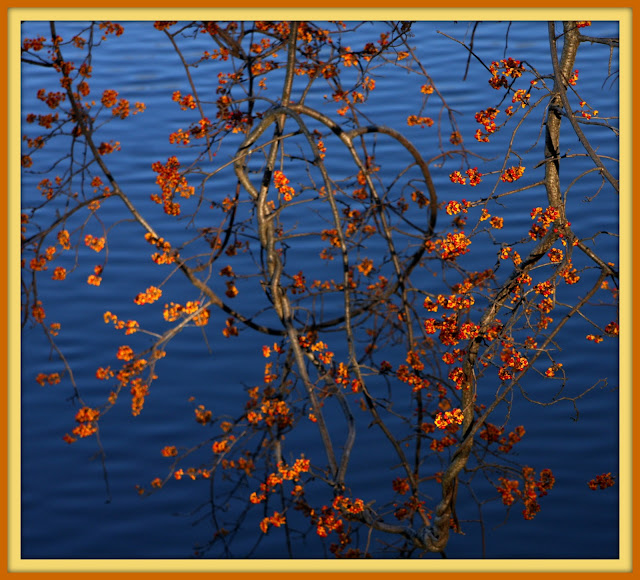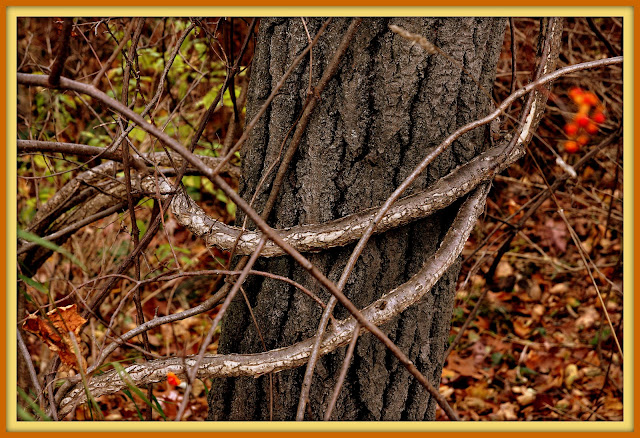Bittersweet
I always look forward to this time of year, very late fall, when the brilliant fruit of the Bittersweet begins its show-off season.
During the summer months this mass of green leaves goes mostly unnoticed, as just another wall of vegetation. These leaves, now turning yellow, are alternate, smooth on both sides, and about 2" X 4" (5-10cm).
Earlier still, (May - June) you may overlook the small, greenish flowers. That's to be expected, since all my Botany books call them "inconspicuous". The tiny flowers (not shown) are only 1/8" (4mm) wide, with 4-5 petals, growing in tight clusters.
Later, about mid-October (in southern Michigan), the leaves begin to drop. The fruit is maturing. If you are outdoors then, and if you are looking, you are likely find these pale orange capsules, 1/2" diameter (4mm) , still closed.
Do you think they resemble miniature pumpkins?
Little gourds?
This is a good overall view of leaves, vines, petioles, and some fruiting capsules beginning to open.
Here, more capsules have dried enough to split open, curl back, and reveal the glossy,
berry-like interior; actually fleshy seeds, in clusters at the stem tips.
As the thin outer shell opens, it usually splits into three parts, and folds back to expose the showy, reddish-orange center. Now is when they call it a bi-colored fruit.
In this view you can see a portion of a small, hard seed, barely exposed from within the deep orange flesh. Also notice how the shell and the interior fruit is divided into thirds, most of the time.
Other names for this plant: American Bittersweet, Climbing Bittersweet, False Bittersweet, Waxwork,, and Staff Tree. The Burning Bush is a close relative. If you have one in your landscape, you may see the resemblance of its berries to Bittersweet.
It is moderately shade tolerant, but prefers the full sun, and will climb an average of 20 to 40 feet (7-13m) to get it. Up to 56 feet (17m) maximum. They may also sprawl and drape over the ground or low shrubbery, or even use its old self for support.
This one near Pickerel Lake (see: Pickerel Lake Loop) climbed 18 - 20 feet (6-7m) up this Red Oak.
Bittersweet grows in a variety of habitats -- in rich soils along roadsides, thickets, riverbanks, and woods. It seems to prefer edges; you will rarely find it deep in the forest.
Here's a nice swirling, twirling batch hanging out over the Grand River, east of Ada, Michigan. This vine was climbing another vine; Wild Grape. Do I see an almost heart-shape in there?
Range: From Quebec to North Carolina, west to Manitoba, Kansas and New Mexico. In the southern parts of its range, it is found at higher elevations.
Unlike many climbing vines, (see my posts: Virginia Creeper, and Virgin's Bower) Bittersweet has no tendrils to cling with. Instead, it spirals tightly around host stems, mainly saplings, and tree trunks. Its grasp is so snug, that it may strangle its own tree or shrub support.
It is common to see two, three, or more vines climbing up one support. It seems the higher up the trunk they go, the tighter they cling.
Bittersweet fruits are mainly dispersed by birds, through their droppings, but it is not a favorite food of wildlife. Seeds are occasionally eaten by game birds, songbirds, and squirrels. The primary consumer of seeds and buds is probably the Ruffed Grouse.
Because of the beauty and ornamental appearance of this vine, and the durability of its fruits, it was once widely collected for decorations.
A generation of stern warnings against cutting it has perhaps saved it. In my personal observations over the past 30 years; not only is it surviving, it is absolutely thriving in our area.
I remember my Grandfather collecting it. I remember my Father collecting it. I've been collecting it for years to give away to friends and family to use for decoration on Thanksgiving Day.
I want to give you these two posters of Bittersweet. Please share them with family and friends.
Have a happy Thanksgiving Day. We have so much to be thankful for.
(Click on photos to enlarge)
Photo Locations:
Cascade Township, (Cascade Township) Michigan
Grand River, (Grand River) Ada Township , Michigan
Pickerel Lake Park, (Pickerel Lake Park) & Cannonsburg, (Cannonsburg) Michigan
Resources:
Forest and Thicket - John Eastman (Eastman)
National Audubon Society Field Guide to Wildflowers (Eastern Region) c 2011 (Audubon)
Fieldbook of Natural History - E. Laurence Palmer c 1949 (Palmer)

















No comments:
Post a Comment
VISITORS:
Please write a comment in the white box. I value your thoughts. I will reply to all who write.
When finished, sign your name, click down arrow, select "Name/URL", or "Anonymous", then click "Publish". Thank you.